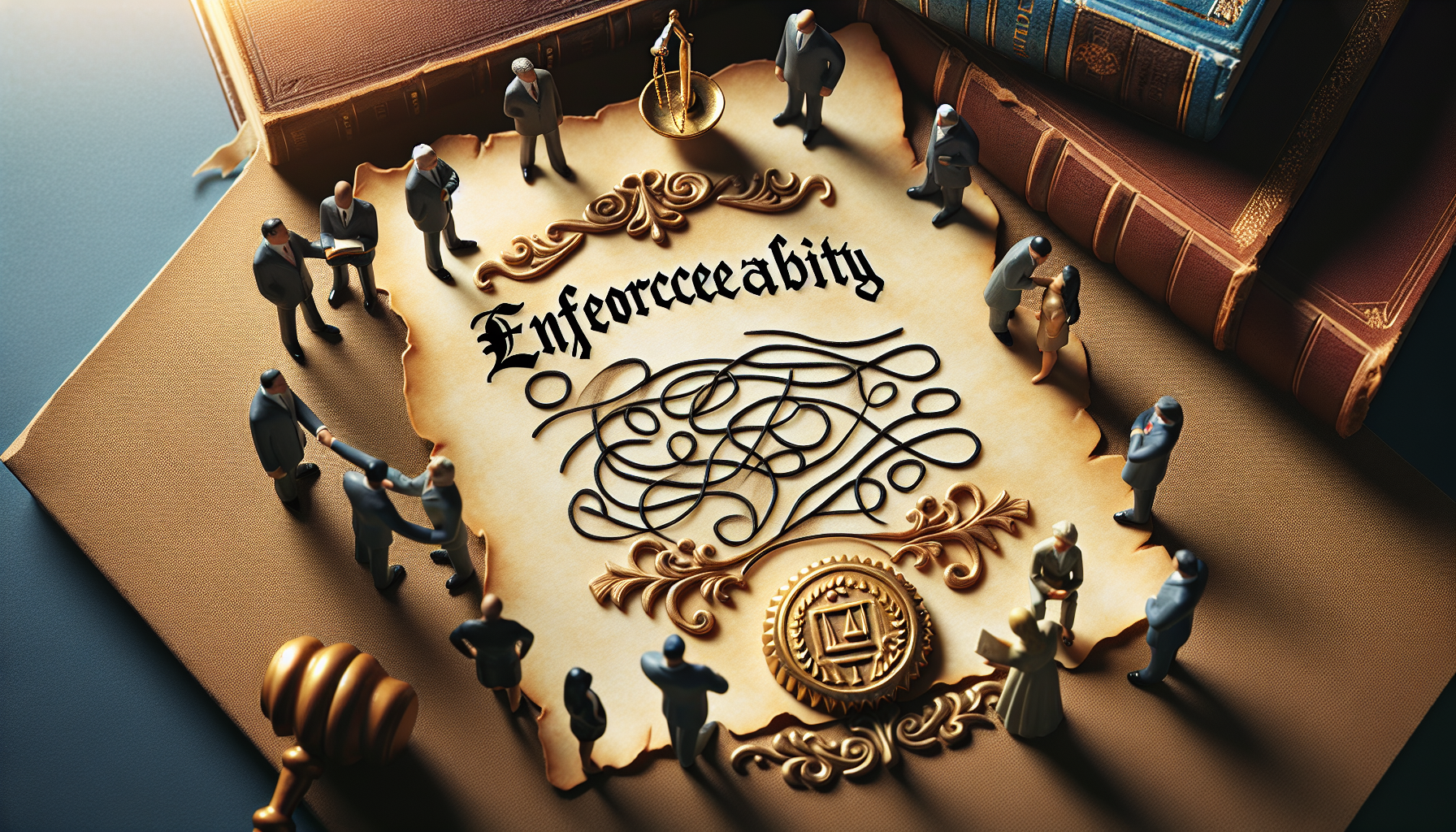Malcolm ZoppiWed May 08 2024
Understanding the Essentials of a Contract in Law
When does an agreement become enforceable under contract law? This pivotal question lies at the heart of every business deal, employment contract, and personal arrangement. A contract in law is a binding promise between parties that the courts can enforce. This article cuts through the complexity, offering a clear exploration of what makes a contract […]
When does an agreement become enforceable under contract law? This pivotal question lies at the heart of every business deal, employment contract, and personal arrangement. A contract in law is a binding promise between parties that the courts can enforce. This article cuts through the complexity, offering a clear exploration of what makes a contract legally valid, the critical terms required, and the consequences if these terms are not met. Expect to understand the skeletons and the flesh of contract law — from inception to enforceability and beyond.
Key Takeaways
A legally binding contract requires specific elements such as mutual consent, offer and acceptance, consideration, legality, and capacity of the parties involved, without which the contract may not be enforceable.
Contracts vary in type, including bilateral, unilateral, express, implied, and simple contracts, each with distinct features and requirements for enforceability, emphasizing the importance of understanding these differences in contractual commitments.
The interpretation of contracts relies on principles such as the objective assessment of terms, the context of the entire agreement, and commercial common sense, with statutory and common law both playing essential roles in determining the enforceability and meaning of contractual terms.
Deciphering the Concept of a Contract

Our daily lives are seamlessly woven with various forms of contracts, often without our realization. From snoozing phone alarms and accepting terms of service to purchasing morning coffee via a sales agreement, the fabric of our routine interactions is threaded with contractual engagements. But what constitutes an actual contract? It transcends a mere agreement. It’s a formal pact that creates legally enforceable duties between parties—turning casual vows into promises backed by legal implications.
Yet not every pact ascends to the stature of an enforceable contract. To forge an authentic binding agreement, specific criteria must be present.
Mutual assent
Proposal and concurrence
Reciprocal consideration
Lawfulness
Capability of involved entities
Much like missing one component can spoil a recipe’s success, omitting any key element from this list undermines the creation of valid contracts. This meticulousness in forming contracts celebrates freedom within its architecture—a nod towards individuals’ right to freely determine their fortunes under lawful conditions.
Understanding nuances in contract law goes beyond scholarly pursuit—it’s crucial for practical proficiency in navigating society’s foundational relationships spanning businesses, consumers, governments or individual conduct. Whether you’re an aspiring entrepreneur or experienced proprietor engaging as consumers or simply interacting on personal levels—you derive power from comprehending these essentials that allow confident transactional engagement laced with anticipatory wisdom.
To delve further: What alchemy turns simple agreements into something far more solid—an enforceable contract capable of standing up against judicial evaluation? The hallmarks indicating successful navigation through the process toward contracting securely lie squarely in mastering those bedrock components required for establishing binding commitments—the anatomy essential for all legally sanctioned pacts.
The Anatomy of a Legally Binding Contract

Delving into the complexities of contract law, one finds the essential components that form every legally binding agreement. These fundamental parts are intrinsically linked and include:
An offer
Acceptance of that offer
Consideration for both parties involved
The intention to establish legal relations
All these elements serve as critical pillars necessary for a contract’s vitality and enforceability. Without them, an arrangement does not possess the strength required to be recognized as a legally binding document in the eyes of the law.
Crafting the Offer
An offer marks the inception of a contract, marking the moment at which one party extends an invitation through a promise that anticipates acceptance and subsequent reward for fulfillment. This overture needs to be explicit and specific, ensuring there’s absolute clarity on the intent to become legally bound upon acceptance. It serves as the opening chapter in our story of contractual engagement—suggesting an exchange beneficial for all parties involved where terms must be unambiguous and intentions crystal clear.
By laying down a valid proposition, it paves way for dialogue, beckoning the offeree to respond with agreement thus commencing participation in what can only be described as a communal dance of contractual consensus. Far from being merely aspirational desires, these are tangible invitations sculpting out prospective deals’ frameworks. Whether immortalized within a written document or spoken aloud as part of verbal assurances—the proposal stands tall like a beacon heralding potential participants into forming lasting commitments enshrined within binding contracts.
Achieving Mutual Assent
When an offer is presented, it sets the stage for the involved parties to reach a mutual understanding – an alignment of wills that crystallizes into agreement. This process involves acceptance, a carefully orchestrated action where the offeree mirrors the tune of the offer with a clear affirmation free from dissent or modifications. It’s important to maintain precision. Even minor deviations in response can alter acceptance into a counteroffer, leading both participants back to negotiate and find their shared tempo again.
In its vigilant role, the legal system scrutinizes this interaction from the perspective of what would be reasonable for any person to understand, confirming that true consensus has been established rather than simply being apparent. This verification process turns informal agreements between contracting individuals into something more substantial: an enforceable contract firmly rooted in law.
Consideration: The Fuel of Contracts
Consideration transforms a mere promise into a binding contract by introducing an element of mutual exchange. This involves transferring something valuable, which could be in the form of cash, services rendered, an agreement to take action or even the decision not to act. The law does not evaluate whether this trade is equal, but simply requires that there must be some forfeiture of a legal right – essentially making a concession as part of entering into the contractual agreement, exemplified by Thomas v Thomas (1842).
Consideration must originate from recent commitments. It cannot rely on previously completed acts unless those past actions are incorporated deliberately within the new contract’s terms. Also, fulfillment of existing obligations recognized in cases like Collins v Godefroy (1831) and Stilk v Myrick (1809), do not qualify as valid consideration because genuine consideration demands contributing something beyond what is already legally required.
As such, Consideration serves as the lifeblood of any contract—it verifies that both parties have indeed invested items or efforts with real value into their formal arrangement. It’s this pivotal component that solidifies their commitment and cements the enforceability underpinning every binding contract.
The Spectrum of Contract Types

Various types of contracts exist, each bearing unique characteristics and legal implications. In bilateral contracts – the most common variant – there is an exchange of promises where both parties agree to fulfill certain duties or abstain from specific actions, thus creating a balance of obligations. Conversely, unilateral contracts resemble a one-sided performance. Here, the promise made by one party is dependent on the other’s completion of a particular deed.
Contracts expressed explicitly are those in which terms are clearly communicated through either written documents or oral agreements. These express contracts lay out intentions straightforwardly with detailed conditions and stipulations visible to everyone involved. On the flip side stand implied contracts, silent understandings acknowledged not through overt communication but deduced from conduct and contextual details inherent to the dealings between parties.
We encounter simple contracts that significantly impact our daily interactions despite their misleading nomenclature. These can range from casual verbal arrangements amongst acquaintances to formalized affairs solidified within written agreements. Form contracts serve as prefabricated frameworks for commonplace accords offering convenience albeit at the expense of customization—a standardized garment amid various contract styles.
The Journey of Contract Formation

The process of forming a contract begins with preliminary discussions, during which the involved parties sketch out potential terms and conditions. Through this early negotiation phase—sometimes formalized in documents like heads of terms or letters of intent—the foundations for mutual understanding are laid, delicately forging ahead towards an agreed-upon end.
Not everyone is permitted to join these proceedings. The requirement of legal capacity acts as a filter that permits only those who possess both the authority and ability to create contracts to participate in the formation process. This prerequisite upholds the validity and reliability of creating a contract by assuring that all parties have what it takes to honor their contractual obligations.
As the draft evolves into something more concrete, attention shifts toward exhaustive scrutiny comparable to perfecting an instrument before its concert debut. Legal principles combined with business practicalities orchestrate this fine-tuning stage so that when complete, the final document stands legally robust while harmonizing perfectly with each party’s needs and anticipations within their respective contracts.
Enforceability: When Contracts Bind

In order for an agreement to be recognized as a legally binding contract, it must encompass specific key elements:
A mutual understanding between parties
Objectives that are in accordance with the law
Parties who have legal capacity
Consideration deemed adequate by law
Compliance with relevant statutory requirements
With these critical components intact, a contract elevates from being just paperwork into an instrument of enforcement and defense within the realm of legal interactions.
This enforceability might prove illusory if ambiguity clouds the terms of the contract due to unequal bargaining power among parties, involvement of minors in its formation, or illicit considerations at play. Life’s unpredictable currents can also lead to situations where performing contractual obligations becomes unfeasible, invoking doctrines like force majeure which disrupts and challenges the core purpose behind forming such agreements.
It is this very quality – enforceability – that grants a legally binding agreement its authority. It enables consequences when there is failure in upholding commitments made under it. Essentially, it transforms simple text into a compelling obligation ensuring all involved parties uphold their promises despite any obstacles they may face.
Navigating Through Commercial Contracts
The realm of commercial contracts is vast and laden with intricacies, requiring precision in crafting to establish a clear balance between the rights and responsibilities of each party. Meticulous attention to detail is essential in safeguarding against unfair terms that could disrupt the equilibrium, particularly disadvantaging one side over another—often the consumer.
Legal professionals experienced in contract law serve as navigators steering through potential perils by offering their expertise. Their guidance helps avoid conflicts stemming from ambiguous interpretations of contractual terms. Within the hold of such agreements are indemnity clauses—akin to lifeboats—that provide assurance for both personal and professional transactions, so parties can weather any disputes without sinking.
In commerce’s lively harbors where business thrives on exchange, contracts are akin to ships transporting commodities, services, and pledges across trade’s oceanic expanse. It falls upon skilled experts who know well contract law’s currents and gales to verify these vessels’ seaworthiness or legal validity before they embark on their journeys through market waters.
Breach and Remedies: The Legal Response to Non-Compliance
When one party fails to uphold their contractual obligations, causing a breach of contract, the legal system offers remedies proportionate with the severity of the infringement. A material breach is equivalent to an extensive fissure in a ship’s hull that threatens its core functionality and warrants robust legal action. Conversely, an anticipatory breach warns of a pending failure by one party signaling their intent not to fulfill impending duties.
Should actual breaches occur — when promised deliverables akin to expected dockings at port do not happen as scheduled — those harmed must chart their course through judicial proceedings. They are tasked with proving three key points: validation of the contract’s existence, identification of unmet obligations, and quantification of consequent damages in pursuit of reparations. Much like tracing and demonstrating how unexpected waves disrupt a voyage.
In terms outlined by UK law regarding redress following such incidents, punitive measures aimed at punishment are eschewed in favor of reparation proportional to actual losses incurred directly from said contract violations. Recoverable financial compensation may either be general—addressing immediate outcomes—or special—for repercussions indirect or unforeseen though nonetheless traceable back to said violation.
Under this framework, there is clarity between liquidated damages prearranged within contracts for enforceability upon transgressions—and penalties which stand invalid typically because they exceed fair boundaries intended to dissuade more than rightful amends. In scenarios where monetary restitution falls short justice requires additional corrective actions. Courts might order specific performance demands reinstating what was initially agreed or annulment potentially setting parties free from binds thus restoring equilibrium within disturbed agreements.
The Intersection of Contract Law with Other Legal Areas
Contract law intersects with various branches of the legal system. In intellectual property (IP) matters, contracts serve as pivotal pathways that legally grant third parties access to someone’s IP rights, providing a mechanism for owners to capitalize on these non-physical assets. The diverse and ever-changing nature of global IP transaction laws adds another layer of complexity due to the interplay between inherent IP rights grounded in property law and those established through contract agreements.
The adaptable nature of contract law enables owners of intellectual property to broaden their protections by crafting private deals that reshape the traditional boundaries set by property principles. This adaptability is clearly seen when considering how SEP holders’ lives are affected. FRAND commitments are interpreted through contractual legal notions which help determine how these promises bind third-parties.
Beyond its role within intellectual property considerations, contract law also permeates other areas like family law — dictating asset division via premarital contracts — and business law — governing formation and termination processes for partnerships and corporations. In civil contexts specifically, it reflects the transformative ability of contract rules as they conform across distinct fields such as private law, underscoring its essential role throughout multifaceted layers within the judiciary framework.
Contract Interpretation: Understanding the Fine Print
Deciphering the meaning of a contract is akin to unlocking the secrets hidden within a cryptic map, requiring astute perception to discern the true intent of its language. In this pursuit, courts adopt an objective standpoint. They ascertain how someone reasonable and privy to all pertinent information known to the contracting parties at inception would interpret said terms. This assessment focuses on three elements: The clear meaning of words used, taking into account their ordinary sense, understanding these in context with respect to the full scope of the contract, as well as applying commercial pragmatism—all serving as fundamental pillars for elucidating contractual stipulations.
The presence of ambiguity shrouds clarity much like mist hinders visibility on a journey towards comprehension. When faced with vague language within contracts, judicial examination becomes more acute—emphasis shifts from mere textual presentation toward revealing and enacting what was truly agreed upon by those engaged in forming said agreement, regardless if explicitly articulated or not. Should there be absence in specificity regarding any aspects therein, it may necessitate judiciary action imposing certain conditions implicitly—the aim being facilitation of efficient functioning reflecting mutual presuppositions inferred between both participants.
Within contract law’s domain exists a hierarchy among expressions utilized—a lexicon where select phrases accrue particular legal connotation borne out from established precedents and habitual application over time. Should technical terminology or industry-specific verbiage emerge within such agreements’ textuality that bear defined interpretations legally recognized become operative unless circumstantial contraindications prevail—an acknowledgment signifying languages dual role conveying communicative intent interwoven amidst juristic legacy ensconced through collective practice amongst professional transactions.
A prominent tenet often invoked when adjudicating disputes related to interpreting contractual documents adheres, namely ‘contra proferentem’. This doctrine presumes that ambiguities found are resolved adversely relative to whom benefits derivatively—a principle less frequented involving sophisticated counterparts exchanging commercially-based covenants—it establishes equitable measure aimed at curtailment against potential usurpation benefiting disproportionally by one party exploiting indeterminate phraseology encompassed anywhere throughout agreeable provisions concerned.
The Role of Statutory Law and Common Law in Contracts
Contract law is intricately entwined with both statutory and common law, which are essential in its governance. Where common law may not provide sufficient guidance or explicitness, statutory law intervenes to bring additional clarity and direction, effectively bridging gaps that might exist due to limitations of precedents or general principles. The interplay between the two forms a fluid dynamic where legislative measures often incorporate and build upon established common-law concepts to better align them with changing societal norms as determined by lawmakers.
Should there be any discordance between statutory and common regulations concerning contracts, it’s understood that statutes will prevail. This dominance represents an active embodiment of public intent through governmental representation. For instance, when contract terms violate specific statutes such as the Statute of Frauds or the Sale of Goods Act, they become unenforceable—a testament to how legislated rules can override conventional legal doctrines.
The power of statute within contract regulation can also serve a protective function for individuals against unfair practices. Legislation like the Unfair Contract Terms. Act 1977 exemplifies this by curtailing excessive exclusion clauses in contractual agreements ensuring equitable confines compatible with fairness standards and overarching social considerations.
Despite these influences from statuary bodies on contract practice parameters, the true foundational infrastructure remains rooted deeply in centuries-old traditions set forth by precedent-driven rulings—common laws still formulating core definitions around contracting behaviors.Thus continues along enduring paths carved out through ongoing judicial examination,counsel argumentation,and consequential adjudications, giving stability and a trustworthy framework for those navigating nuanced territory inherent in drafting and implementing legally binding obligations known simply as contracts.
Your Guide to Contractual Agreements with Gaffney Zoppi
Navigating the intricate domain of contract law can seem daunting. With the skilled assistance of Gaffney Zoppi’s team of expert contract lawyers, this complexity is transformed into a clear path towards empowerment and safeguarding interests. The firm prides itself on delivering tailor-made contracts that are scrupulously designed to align with the unique needs prevalent among small businesses in the UK. By taking a proactive stance in client engagement, they provide finely tuned services addressing individual requirements for various clientele segments including entrepreneurs, shareholders, service providers among others.
Gaffney Zoppi has earned acclaim not just for its adept legal document crafting, but equally for its outstanding service level commitment. They expedite contract reviews and prioritize communication—ensuring phone calls are responded to or returned within one business day while emails receive timely replies—to guarantee clients have swift access to necessary guidance and support when it counts most. Such promptness exemplifies their unwavering dedication to ensuring customer satisfaction.
Gaffney Zoppi demonstrates an unyielding commitment toward clarity and cost-effectiveness through offering competitive fixed rates on their lawyer services concerning contracts. This approach allows clients peace of mind by providing transparency regarding expenses without hidden charges lurking down the line. With easy online interaction and help readily available via their website interface, acquiring elite expertise in contract law is both straightforward and convenient. Whether it involves creating new agreements or analyzing existing ones so all your contracts adhere firmly to legal standards – Gaffney Zoppi offers reliable support as your trustworthy partner throughout every aspect of contractual affairs.
Summary
We’ve explored the extensive realm of contract law, encompassing everything from the essential components that forge a legally binding contract to the detailed aspects of business deals, their enforceability, and how they’re influenced by both statutory regulations and common law precedents. It’s become evident through our journey that contracts transcend simple pieces of paper. They serve as vital conduits for commercial transactions, underpin personal agreements, and protect legal relations between parties. When crafted with attention to detail and legal acumen by proficient attorneys, contracts can be formidable tools promoting stability and facilitating growth.
As you depart from your immersion in contract law education remember these crucial insights: the significance of formulating precise offers is paramount, securing mutual assent critical, ensuring there is valuable consideration imperative. Not overlooking careful scrutiny when reading contractual terms is advisable. Should uncertainties arise, do not hesitate to consult experts such as Gaffney Zoppi who specialize in demystifying complex legalese thus leading you towards secure trading conditions where potential thrives. Harness well-drafted contracts’ full potential so they may stand firmly behind your commitments while serving as steadfast vehicles driving toward realizing your ambitions.
Frequently Asked Questions
What distinguishes a legally binding contract from a simple agreement?
A binding contract, which is legally enforceable, differs from a mere agreement as it necessitates particular components including mutual assent (comprising offer and acceptance), adequate consideration, legal purpose, and the contractual capacity of all involved parties. These elements are not obligatory for informal agreements.
Can a verbal agreement be considered a legally binding contract?
Certainly, if a verbal agreement fulfills the necessary criteria, it can establish a legally binding contract. Demonstrating its specifics may pose more challenges than with a binding contract that is documented in writing.
What is the role of consideration in contract formation?
In the process of forming a contract, consideration plays a vital role because it involves the exchange of something valuable between parties involved—this could be in the form of cash, services, or commitments. For a contract to hold up legally, there must be consideration that is concurrent with the agreement and not reliant on prior deeds.
How does statutory law influence contract law?
By plugging loopholes, offering clear guidance, and superseding common law when discrepancies arise, statutory law plays a pivotal role in shaping contract law. It enhances the scope of legal principles and reflects the latest legislative intent.
What services does Gaffney Zoppi provide for those needing assistance with contracts?
Gaffney Zoppi specializes in contract law by delivering customized contract creation, conducting thorough reviews of contracts, and providing expert legal counsel on various facets of contract-related matters. They prioritize prompt service delivery while ensuring their fees remain competitive and fixed.